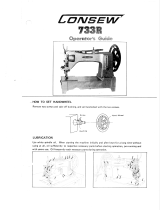
17
3.6.4.2.3 Replacement of the feeder
For the replacement of the wheel feeder (change of the wheel
feeder according to the machine setting - see par. 11.2 - setting
of the machine - feeder - pitch of the teeth).
Caution! Danger of injury!
Switch off the main switch! Before starting the setting
operation, wait until the motor stops!
- Unscrew the screws (1) and remove the throat plate (2).
- Dismantle the hook of the left-hand post (see 3.1.8).
- In pulling upwards (securing by a spring), pull out the feeder
(3) with the guide (4).
- Replace the feeder (3).
- Insert the feeder with the guide into the groove of the holder
(5).
- Mount the hook of the left-hand post (see 3.1.8).
- Mount the throat plate (2) and tighten up the screws (1).
- Check up, if the spring (6) pushes the guide (4) with the feeder
(3) against the wheel (8).
- In the opposite case, loosen the screws (9),tense up the spring
in such a way,so that the guide (4) with the feeder (3) is pushed
against the wheel (8) and tighten the screws (9).
3.6.5 Setting the top roller (pressing force, height)
When lowering the top roller (1), set the clearance A between
the feeder (5) and the top roller to the maximum of 0.2 mm.
Set the pressing force of the top roller (1) so as to avoid the
slippage of the sewn material when feeding it.
Method of setting the height of the top roller:
- Lower by hand the presser bar (3) with the top roller (1) above
the wheel feeder (5).
- Loosen the screw (4) and set the required value A (0.2 mm).
- Tighten the screw (4).
Setting the force of the top roller (1).
- In screwing in the screw (2),the force of the top roller is
increased and inversely.
3.7 Feeding mechanism of the top roller
3.7.1 Description
The starting movement for the drive of the top roller feeder is the
bottom feeding shaft. From this shaft, the movement is transmitted
by the indented belt (1) onto the top feeding shaft (2). A component
part of the transmission by indented belt is the pulley (3), the
tensioning roller (4), the roller (5) and the pulley (6). Starting
from the shaft (2), the movement is further transmitted through
the friction wheels (7 and 8) of drive conversion unit onto the
articulated shaft (9). From this articulated shaft, the movement
is transmitted by a cone transmission, situated in the holder
(10), onto the feeder wheel (11). The drive conversion unit
serves for compensating the differences in feeding by the
driven top roller and by the lower feed wheeler. By turning the
screw (12), the change of the gear speed ratio is attained.
After having set in accordance with the par. 3.6.6, the screw
(12) in the holder (13) is to be locked by the nut (14). The
pressure of the friction wheels (7 and 8) is ensured by the
compression spring in the shaft (2). To avoid a complete
pushing out from the arm, the shaft is locked by a stirrup ring
(17). The shaft of the friction wheel (8) is mounted in the
screw (12) on needle bearings. The articulated shaft (9)
contains two joints (15) and a telescopic part (16). Both these
elements secure the lifting
and the tilting of the top roller.
6
9
3
4
5
8
2
4
3
1
5
A
2
1
62
5
1
4
3
15
9
16
15
10
11
178131214
7






























